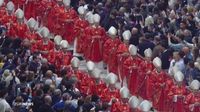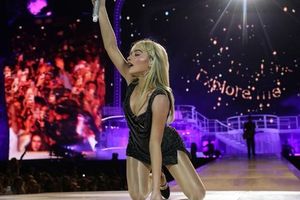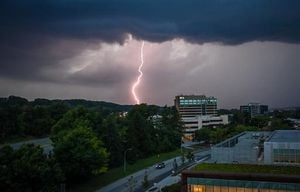The world turned its eyes to the Vatican as the conclave to elect the new Pope commenced on Wednesday, May 7, 2025. However, the first day ended without a result, leaving thousands of eager spectators in suspense.
At 21:05, black smoke billowed from the chimney of the Sistine Chapel, signaling that no Pope had been elected during the first round of voting. This was nearly two hours later than the Vatican's official schedule, which had anticipated the first smoke signal between 19:00 and 19:30. The delay sparked confusion and speculation among the tens of thousands of faithful gathered in St. Peter's Square, all eagerly awaiting news of the Church's new leader.
As the crowd anxiously gazed at the chapel's roof, they were met with disappointment as the expected white smoke—indicating the election of a new Pope—did not appear. Instead, the black smoke served as a reminder that the process of selecting the 267th Pope in the history of the Church would not be as swift as many had hoped.
The delay in the announcement of the first smoke signal was attributed to reasons that remain unclear. Some observers speculated about possible technical issues with the smoke apparatus, while others pondered whether there had been a medical emergency or if the cardinals had decided not to conduct a second ballot on the first day. However, no official information was released to clarify the situation.
The day of the conclave began on Tuesday, May 6, 2025, at 10:00 with the mass "Pro Eligendo Pontifice" held in St. Peter's Basilica. Cardinal Dean Giovanni Battista Re, aged 91, officiated the mass, attended by the 133 eligible cardinals who would participate in the conclave.
In the afternoon, the cardinals entered the Sistine Chapel, where they would remain in strict secrecy as they deliberated on the successor to Pope Francis, who passed away on Monday, May 5, 2025. Following the oath of secrecy, the first ballot commenced around 17:45, and the door to the chapel was sealed with two firm knocks, isolating the cardinals from the outside world.
This conclave is notably large and internationally diverse, with Pope Francis having appointed many new church leaders from various countries. This means that a two-thirds majority, which is required for election, will now require 89 votes. Observers have suggested that this could lead to a longer election process than in previous conclaves, which have typically concluded within two to three days since the 1960s.
As the first day of voting concluded without a new Pope, the cardinals retired to the Santa Marta guesthouse for the night. The conclave is set to continue on Thursday, May 8, 2025, with two ballots scheduled for the morning and two more in the afternoon. The anticipation remains high as the world awaits the announcement of the new leader of the Catholic Church.
The election of a new Pope is not just a religious event; it represents a significant moment in the history of the Church and the global community. With the eyes of millions upon them, the cardinals face the weighty responsibility of choosing a leader who will guide the Church into its next chapter.
As the conclave unfolds, many are left to wonder how long it will take to reach a decision. Will the cardinals find common ground soon? Or will the search for the new Pope become a longer endeavor than expected? Only time will tell, but the stakes have never been higher.




